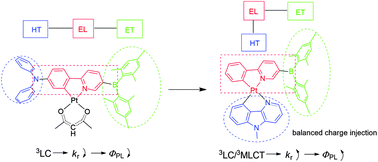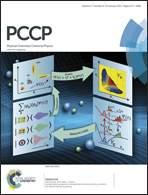Theoretical study and design of multifunctional phosphorescent platinum(ii) complexes containing triarylboron moieties for efficient OLED emitters†
Abstract
The geometries, electronic structures, photophysical properties and spin–orbit coupling (SOC) effects in the radiative process for the recently synthesized complexes (Bppy)Pt(acac) (1) and (BNppy)Pt(acac) (2) as well as the designed complexes 3–6 were investigated by DFT and TD-DFT calculations, to reveal the influences of the functional ligands on charge injection ability and phosphorescence efficiency of emitters. It is found that compared with electron acceptor complex 1, complexes 2–6 have lower ionization potentials and comparable high electronic affinities, which are suited for bipolar luminescent materials. The results also demonstrated that Bppy complexes 1, 5 and 6 have more 3MLCT compositions in T1 emitting states compared with BNppy complexes 2–4, which results in strong SOC and fast kr. Thus, the phosphorescence efficiency of 1 is higher than that of 2. In addition, 5 and 6 have the balanced charge transport and better hole injection ability when the hole-transporting ligand is incorporated to 1. Therefore, 5 and 6 can server as promising candidates for efficient multifunctional phosphorescent OLED emitters owing to their ambipolar characters, balanced charge carrier injection/transport features and high phosphorescence quantum efficiency.


 Please wait while we load your content...
Please wait while we load your content...